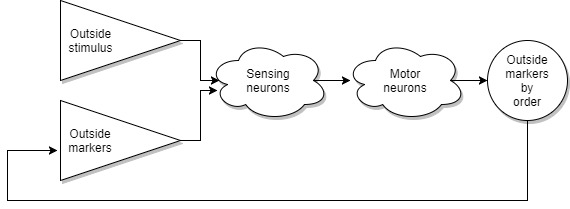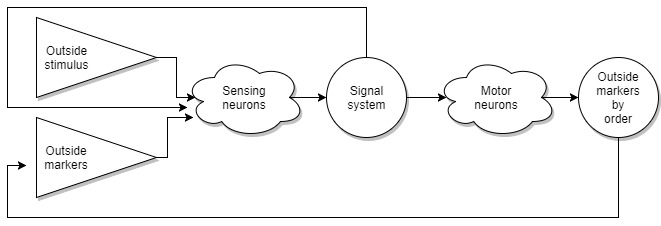Charles Darwin presented to us an excellent theory about the origin and development of life on Earth. True, it still has a lot of questions and controversial issues. But at this stage, we don’t have the best. The biggest problem with Mr. Darwin’s theory is that we can guess and speculate how and why everything happened, but we cannot test or disprove this theory. I propose to use the theory of evolution as a pattern to imagine how the nervous system developed and what processes led to the emergence of consciousness. We will discuss possible prospects for such an approach later.
We close our eyes and represent.
A more formal English version is
here .
We have a whole ocean of single cells that are streamed or float in puddles. During the day, the sun heats them, and at night they cool down. We can imagine that at some point the cells learned to shrink and thereby acquired the ability to move, which, together with the ability to recognize the temperature, gave them the opportunity to move, and over time, reducing only one side, they began to move in a more comfortable direction.
But some still moved in the wrong direction and died, and their dead bodies, decomposing, created a chemical marker for such places, and other individuals learned over time to distinguish such markers. Also, over time, the ability of sensors to recognize markers grew, and we can see that over time they learned to recognize not only heat / cold, but also dangerous places where decomposition markers are felt, and places where there is food. I propose to call such a system external markers.
The system of external markers is, in fact, very simple, when there is a certain stimulus on the external sensor, then a specific part of the body is reduced to provide movement to or from the stimulus. You can imagine this as a motor with a switch, where an external stimulus plays the role of a switch. For example, an ant transfers a fallen leaf to a shank, because a special chemical marker made by nature itself is present on the shank, and an ant bumping into it starts a leaf dragging algorithm.

Observing the insects, we can see that the system of external markers to order has become the next development step. At some point in time, we can assume that external sensors have learned to distinguish not only the chemistry of decomposition, but also the chemical markers of living individuals, and nature has not missed the opportunity to create organs capable of producing different excretions for environmental labels. This is also a very simple system. For example, if there is a certain stimulus as a switch, the animal may hear noise and get scared. It leaves a mark in the form of urine or feces as a marker for others, that this is a dangerous place. It is very similar to a primitive communication system. We can assume that initially this happened at the moment when individuals learned to distinguish their mark and go back through it to the comfort zone, or other individuals could follow the first one. Maybe at night they were more comfortable being together. We can see a system with external markers to order in almost all living things. True, in people it is more often seen, for example, in such a household event as shopping. When the female has left chemical markers on a piece of paper, and the male sees the matching markers on the shelf, picks it up and puts it in the basket, deletes it on the list. :)

But with the growth of body size, evolution faced a couple of problems. As the number of cells in one individual grew, so did the number of sensors that had to be processed. And on this path evolution has collected the maximum number of signal processing chains in one place. In addition, all informational heavy sensors, sight, hearing, smell, were not very far.
Another problem was that it became necessary to switch the entire set of cells into different modes of operation simultaneously. For example, sleep, calm, panic, aggression. It is not possible to implement this with the help of leading the command nerves to each cell. And in this case, evolution did not invent anything new, but simply used the old trick with markers. Only now it has become markers inside the body. That is, mechanisms appeared that began to produce certain markers that are carried by the blood throughout the body. The cells, irritated by the marker, change their mode of operation. Call it a signaling system. The simplest and most well-known example of the operation of the signal system is a panic attack. When, in the presence of certain stimuli, the system begins to produce adrenaline.

And here we come to the most interesting. At some unknown stage, it happened that some individuals lost the ability to recognize external markers. In cetaceans, sirens, the majority of bats and narrow-nosed primates, including humans, the vomeronasal organ is rudimentary or completely lost. In fact, we, of course, cannot know what happened, whether the buildup of markers in the signal system was primary and the system of external markers was not needed. Or first, for some reason, the system of external markers became unavailable and then the buildup of markers in the internal signal system began. In the case of a person, more than 100 internal markers are currently known. It is also known that human hormones can affect animals. But animal hormones either have no effect on humans, or their reaction is very weak. That is, we can assume that the human signaling system is much more developed than that of animals. And perhaps this is exactly the line that distinguishes us.
But back to the theme of the emergence of consciousness.
At this stage of our theoretical research, we have come to the conclusion that we have a system of switches that, when stimulated, do some work. At the same time, all these switches are physically collected in one place and the outermost of them have sensors or nerves as connections.
We also have a signal system that is controlled by the same switches. But at the same time, the switches themselves are able to respond to the signal system markers. That is, we can imagine it as a vicious circle. The switches control the alarm system, the alarm system acts on the switches.
Having 100 markers in the signal system, this gives us 2 ^ 100 choices of cocktails from the markers, which gives us a huge number of options for recording messages between cells. Let's imagine that a group of switches, when it was created, remembers the cocktail of markers that existed at that moment and later when a similar cocktail appeared, this group would become active. This provides us with a connection between various physically remote groups, and the activation of groups in similar situations. Also, do not forget that the production of markers is controlled by groups of switches. For example, I will be very exaggerating if we want to work out a block from a strike. Physically, the visual area that is responsible for recognizing the impact is far (within the distance between the cells) from the area of muscle control. Suppose that at the first stage, communication between these two groups of switches will occur at the level of the signal system. That is, the visual area will order a message in the “signal system” in which there will be a message for the motor system to perform some kind of action. All this will take some time. But it is quite logical that if one and the same action is repeated for several years, the systems of switches sending and receiving messages will polish this action to the ideal, relieve the “signal system” of unnecessary markers generating variability of actions, and it will go almost to the level of reflexes.

Summarizing what has been said, we can say that consciousness is an infinite closed loop of two systems that act on each other, triggers and hormonal, in an attempt to find balance. At the same time, external stimuli introduce their own corrections and break the balance. Emotions in this case is nothing more than a side effect of the operation of these systems.
To confirm this model, we need to detect neurons that interact with the entire spectrum of hormones, which seems to be a little possible at this level of technology development. Such neurons are counted in several thousand for each hormone, in the total mass of almost hundreds of billions of neurons.
In the next part, we will take a closer look at how to organize what we call consciousness from a set of triggers and a signal network. As an example, we will use the implemented computer model at an early stage of training.